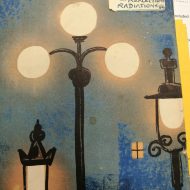The May Gibbs Creative Time Fellowship

I’m in Brisbane currently, having completed two weeks of the May Gibbs Creative Time Fellowship – and, although I don’t want to repeat anything from my blog post on that, I do want to talk about the research and writing side of this project here, as a way of chronicling that process.
A lot of the story is set in Brisbane, so it’s wonderful to be writing it here where I can divide my time between research and writing. I’ve been doing a lot of reading about the war years on the Australian home front, but also on childhood in Australia during the second world war and obscure articles on more specialised areas, such as flat-dwelling in Brisbane during that time. I’m keeping all my research notes together – and handwriting a lot of them, rather than photocopying them. I’m doing this partly to keep them all in the same place, and partly because the mechanical act of handwriting helps me think about what I’m reading and I’m sure this lodges in my brain, to percolate ideas about how the information can be used for my story. Of course, I have also photocopied some items when a whole chapter was too relevant.
I’ve also been wandering around Brisbane – down to the Valley and past Oxlades where my mother can remember buying her art materials, to the river to smell the mangroves and feel the weight of the humidity and back up to the city, past Rowes Arcade where there used to be tea rooms.
Most of my research to date has been conducted at the State Library of Queensland – some up on Level 4 where the John Oxley is. The May Gibbs Children’s Lit people organise library cards at SLQ and the municipal library. I don’t think anyone has used the John Oxley lately because there was some consternation about the May Gibbs card. A librarian said to me, ‘May Gibbs is dead, you know.’ I had to explain that I wasn’t impersonating her!
I also spent an hour and a half skimming Truth newspaper over the years 1939 – 1940, years my grandfather worked on Truth. Newspapers and magazines are a wonderful resource for all sorts of things other than the news. I’ve noted advertising copy, for example, both for the kinds of description used and pricing. Truth had some wonderfully lurid stories – it was no wonder that the librarian who helped me load the microfiche said she wasn’t allowed to read it as a child!
On Friday I went to the Fryer Library at University of Queensland where a lot of our family papers are kept. A key figure in my story is my central character’s Aunt Henrietta, a character based on my grandmother’s cousin, Australian writer Ernestine Hill. They were extremely close and, when they weren’t living in the same city, kept up an intimate correspondence. The Fryer also holds Ernestine’s notebooks – many written in her idiosyncratic shorthand. I spent most of the afternoon looking at a few boxes of notebooks but I’ll return there later this week to read the correspondence.

One of Ernestine Hill’s notebooks, Fryer Library
My biggest challenge in all this work is to shift this narrative from the province of family history and anecdote and turn it into fiction. I’ve made some plot and theme decisions I’m happy with, given myself permission to mess with the timeline and cut an entire city (Melbourne) out of the story. This sounds like the normal work of the novelist but, because this is historical, perhaps, I find it quite difficult to do. Odd, because I use bits and pieces willy nilly from my own life, fictionalising to the point where I sometimes don’t know what really happened and what I invented.
During the first week of the fellowship, I found my character’s voice – such a relief! I’m now over 5000 words into the project having completed three chapters. I’m not hurrying the writing. There’s a lot that needs to slip into the story without it being strained or overwhelmed. In this sense, historical fiction requires world-building just as does fantasy or science fiction. The language, social mores, family activities and schoolyard politics must subtly suggest a different time. I do rather feel as though everything I write from now on might be set during this time period!
It was immensely gratifying to discover Barbara Hanrahan feature in a display-in-progress at the Fryer. Hanrahan does time and place so beautifully and while I certainly don’t expect to create the kind of lush, evocative landscapes she achieves, I’m holding her close as the background patron saint of this project.

Barbara Hanrahan works from the Fryer.
